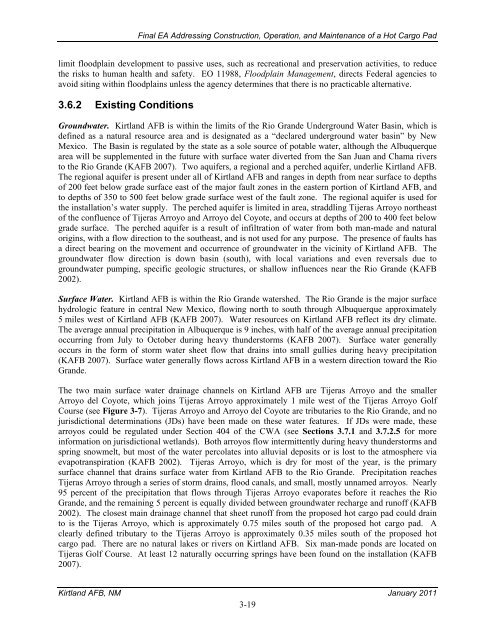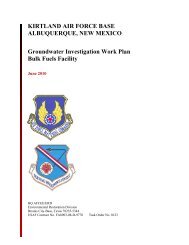Final FONSI and EA for hot cargo pad on Kirtland AFB - Kirtland Air ...
Final FONSI and EA for hot cargo pad on Kirtland AFB - Kirtland Air ...
Final FONSI and EA for hot cargo pad on Kirtland AFB - Kirtland Air ...
You also want an ePaper? Increase the reach of your titles
YUMPU automatically turns print PDFs into web optimized ePapers that Google loves.
<str<strong>on</strong>g>Final</str<strong>on</strong>g> <str<strong>on</strong>g>EA</str<strong>on</strong>g> Addressing C<strong>on</strong>structi<strong>on</strong>, Operati<strong>on</strong>, <str<strong>on</strong>g>and</str<strong>on</strong>g> Maintenance of a Hot Cargo Pad<br />
limit floodplain development to passive uses, such as recreati<strong>on</strong>al <str<strong>on</strong>g>and</str<strong>on</strong>g> preservati<strong>on</strong> activities, to reduce<br />
the risks to human health <str<strong>on</strong>g>and</str<strong>on</strong>g> safety. EO 11988, Floodplain Management, directs Federal agencies to<br />
avoid siting within floodplains unless the agency determines that there is no practicable alternative.<br />
3.6.2 Existing C<strong>on</strong>diti<strong>on</strong>s<br />
Groundwater. Kirtl<str<strong>on</strong>g>and</str<strong>on</strong>g> <strong>AFB</strong> is within the limits of the Rio Gr<str<strong>on</strong>g>and</str<strong>on</strong>g>e Underground Water Basin, which is<br />
defined as a natural resource area <str<strong>on</strong>g>and</str<strong>on</strong>g> is designated as a “declared underground water basin” by New<br />
Mexico. The Basin is regulated by the state as a sole source of potable water, although the Albuquerque<br />
area will be supplemented in the future with surface water diverted from the San Juan <str<strong>on</strong>g>and</str<strong>on</strong>g> Chama rivers<br />
to the Rio Gr<str<strong>on</strong>g>and</str<strong>on</strong>g>e (K<strong>AFB</strong> 2007). Two aquifers, a regi<strong>on</strong>al <str<strong>on</strong>g>and</str<strong>on</strong>g> a perched aquifer, underlie Kirtl<str<strong>on</strong>g>and</str<strong>on</strong>g> <strong>AFB</strong>.<br />
The regi<strong>on</strong>al aquifer is present under all of Kirtl<str<strong>on</strong>g>and</str<strong>on</strong>g> <strong>AFB</strong> <str<strong>on</strong>g>and</str<strong>on</strong>g> ranges in depth from near surface to depths<br />
of 200 feet below grade surface east of the major fault z<strong>on</strong>es in the eastern porti<strong>on</strong> of Kirtl<str<strong>on</strong>g>and</str<strong>on</strong>g> <strong>AFB</strong>, <str<strong>on</strong>g>and</str<strong>on</strong>g><br />
to depths of 350 to 500 feet below grade surface west of the fault z<strong>on</strong>e. The regi<strong>on</strong>al aquifer is used <str<strong>on</strong>g>for</str<strong>on</strong>g><br />
the installati<strong>on</strong>’s water supply. The perched aquifer is limited in area, straddling Tijeras Arroyo northeast<br />
of the c<strong>on</strong>fluence of Tijeras Arroyo <str<strong>on</strong>g>and</str<strong>on</strong>g> Arroyo del Coyote, <str<strong>on</strong>g>and</str<strong>on</strong>g> occurs at depths of 200 to 400 feet below<br />
grade surface. The perched aquifer is a result of infiltrati<strong>on</strong> of water from both man-made <str<strong>on</strong>g>and</str<strong>on</strong>g> natural<br />
origins, with a flow directi<strong>on</strong> to the southeast, <str<strong>on</strong>g>and</str<strong>on</strong>g> is not used <str<strong>on</strong>g>for</str<strong>on</strong>g> any purpose. The presence of faults has<br />
a direct bearing <strong>on</strong> the movement <str<strong>on</strong>g>and</str<strong>on</strong>g> occurrence of groundwater in the vicinity of Kirtl<str<strong>on</strong>g>and</str<strong>on</strong>g> <strong>AFB</strong>. The<br />
groundwater flow directi<strong>on</strong> is down basin (south), with local variati<strong>on</strong>s <str<strong>on</strong>g>and</str<strong>on</strong>g> even reversals due to<br />
groundwater pumping, specific geologic structures, or shallow influences near the Rio Gr<str<strong>on</strong>g>and</str<strong>on</strong>g>e (K<strong>AFB</strong><br />
2002).<br />
Surface Water. Kirtl<str<strong>on</strong>g>and</str<strong>on</strong>g> <strong>AFB</strong> is within the Rio Gr<str<strong>on</strong>g>and</str<strong>on</strong>g>e watershed. The Rio Gr<str<strong>on</strong>g>and</str<strong>on</strong>g>e is the major surface<br />
hydrologic feature in central New Mexico, flowing north to south through Albuquerque approximately<br />
5 miles west of Kirtl<str<strong>on</strong>g>and</str<strong>on</strong>g> <strong>AFB</strong> (K<strong>AFB</strong> 2007). Water resources <strong>on</strong> Kirtl<str<strong>on</strong>g>and</str<strong>on</strong>g> <strong>AFB</strong> reflect its dry climate.<br />
The average annual precipitati<strong>on</strong> in Albuquerque is 9 inches, with half of the average annual precipitati<strong>on</strong><br />
occurring from July to October during heavy thunderstorms (K<strong>AFB</strong> 2007). Surface water generally<br />
occurs in the <str<strong>on</strong>g>for</str<strong>on</strong>g>m of storm water sheet flow that drains into small gullies during heavy precipitati<strong>on</strong><br />
(K<strong>AFB</strong> 2007). Surface water generally flows across Kirtl<str<strong>on</strong>g>and</str<strong>on</strong>g> <strong>AFB</strong> in a western directi<strong>on</strong> toward the Rio<br />
Gr<str<strong>on</strong>g>and</str<strong>on</strong>g>e.<br />
The two main surface water drainage channels <strong>on</strong> Kirtl<str<strong>on</strong>g>and</str<strong>on</strong>g> <strong>AFB</strong> are Tijeras Arroyo <str<strong>on</strong>g>and</str<strong>on</strong>g> the smaller<br />
Arroyo del Coyote, which joins Tijeras Arroyo approximately 1 mile west of the Tijeras Arroyo Golf<br />
Course (see Figure 3-7). Tijeras Arroyo <str<strong>on</strong>g>and</str<strong>on</strong>g> Arroyo del Coyote are tributaries to the Rio Gr<str<strong>on</strong>g>and</str<strong>on</strong>g>e, <str<strong>on</strong>g>and</str<strong>on</strong>g> no<br />
jurisdicti<strong>on</strong>al determinati<strong>on</strong>s (JDs) have been made <strong>on</strong> these water features. If JDs were made, these<br />
arroyos could be regulated under Secti<strong>on</strong> 404 of the CWA (see Secti<strong>on</strong>s 3.7.1 <str<strong>on</strong>g>and</str<strong>on</strong>g> 3.7.2.5 <str<strong>on</strong>g>for</str<strong>on</strong>g> more<br />
in<str<strong>on</strong>g>for</str<strong>on</strong>g>mati<strong>on</strong> <strong>on</strong> jurisdicti<strong>on</strong>al wetl<str<strong>on</strong>g>and</str<strong>on</strong>g>s). Both arroyos flow intermittently during heavy thunderstorms <str<strong>on</strong>g>and</str<strong>on</strong>g><br />
spring snowmelt, but most of the water percolates into alluvial deposits or is lost to the atmosphere via<br />
evapotranspirati<strong>on</strong> (K<strong>AFB</strong> 2002). Tijeras Arroyo, which is dry <str<strong>on</strong>g>for</str<strong>on</strong>g> most of the year, is the primary<br />
surface channel that drains surface water from Kirtl<str<strong>on</strong>g>and</str<strong>on</strong>g> <strong>AFB</strong> to the Rio Gr<str<strong>on</strong>g>and</str<strong>on</strong>g>e. Precipitati<strong>on</strong> reaches<br />
Tijeras Arroyo through a series of storm drains, flood canals, <str<strong>on</strong>g>and</str<strong>on</strong>g> small, mostly unnamed arroyos. Nearly<br />
95 percent of the precipitati<strong>on</strong> that flows through Tijeras Arroyo evaporates be<str<strong>on</strong>g>for</str<strong>on</strong>g>e it reaches the Rio<br />
Gr<str<strong>on</strong>g>and</str<strong>on</strong>g>e, <str<strong>on</strong>g>and</str<strong>on</strong>g> the remaining 5 percent is equally divided between groundwater recharge <str<strong>on</strong>g>and</str<strong>on</strong>g> runoff (K<strong>AFB</strong><br />
2002). The closest main drainage channel that sheet runoff from the proposed <str<strong>on</strong>g>hot</str<strong>on</strong>g> <str<strong>on</strong>g>cargo</str<strong>on</strong>g> <str<strong>on</strong>g>pad</str<strong>on</strong>g> could drain<br />
to is the Tijeras Arroyo, which is approximately 0.75 miles south of the proposed <str<strong>on</strong>g>hot</str<strong>on</strong>g> <str<strong>on</strong>g>cargo</str<strong>on</strong>g> <str<strong>on</strong>g>pad</str<strong>on</strong>g>. A<br />
clearly defined tributary to the Tijeras Arroyo is approximately 0.35 miles south of the proposed <str<strong>on</strong>g>hot</str<strong>on</strong>g><br />
<str<strong>on</strong>g>cargo</str<strong>on</strong>g> <str<strong>on</strong>g>pad</str<strong>on</strong>g>. There are no natural lakes or rivers <strong>on</strong> Kirtl<str<strong>on</strong>g>and</str<strong>on</strong>g> <strong>AFB</strong>. Six man-made p<strong>on</strong>ds are located <strong>on</strong><br />
Tijeras Golf Course. At least 12 naturally occurring springs have been found <strong>on</strong> the installati<strong>on</strong> (K<strong>AFB</strong><br />
2007).<br />
Kirtl<str<strong>on</strong>g>and</str<strong>on</strong>g> <strong>AFB</strong>, NM January 2011<br />
3-19
















